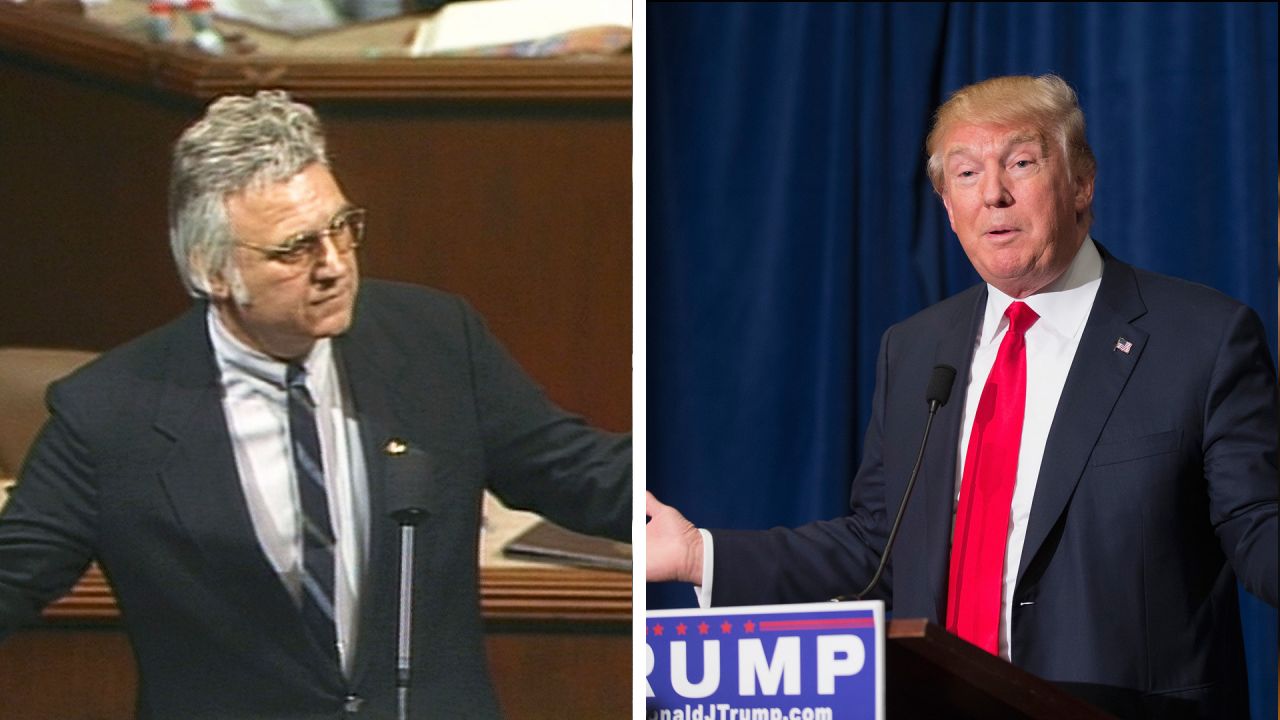
Left: Rep. James Traficant (D-Ohio) speaks before members of the House of Representatives July 24, 2002. (House TV/Getty Images) Right: Republican presidential candidate Donald Trump. (Photo by Scott Olson/Getty Images)
EDITOR’S NOTE: As many experts have observed, this year’s presidential election could come down to a battle for votes Democrats used to take for granted.
Donald Trump is making an overt play for the so-called “Reagan Democrats,” blue collar voters whose defection three decades ago shook up the national political landscape and stoked the Reagan revolution. It’s no accident that Hillary Clinton’s first post-convention foray was into once reliably Democratic steel and coal country. Now, as then, the issues facing these voters are job and income security in a changing world. Only now, those concerns are being felt by far more than the steelworkers and their families whom Ronald Reagan wooed in 1980.
America’s deindustrialized heartland embodies one of the challenges reshaping the nation’s politics: The disappearance of the middle class and the growing gap between the haves and have-nots. That’s why BillMoyers.com is paying particular attention to these communities this year, focusing on their issues and giving voice to the people who live there. You can read more of our collection here.)
Years before Donald Trump and his red power tie rewrote the rules of presidential politics, former Ohio Rep. James A. Traficant Jr., the son of a truck driver, emerged from the dying steel city of Youngstown, Ohio, to rage against the economic forces that were reshaping wide swaths of the industrial Midwest. From the bizarre hair to the populist swagger and the closed-border rhetoric, Youngstown’s controversial congressman prefigured the rise of Trump and Trumpian politics.
Today, Trump is taking much of the spirit of Traficant’s career to the national stage as the economic forces that laid much of Youngstown low have spread throughout post-Great Recession America.
Youngstown’s once-mammoth industrial base earned it the nickname “America’s Ruhr Valley.” More steel emerged from the Youngstown district’s furnaces in 1950 than in any other similar-sized area in the world. And with the fifth-highest rate of home ownership in the country, the city and the Mahoning Valley symbolized an emergent American working class.
The fall of Youngstown also mirrors the trajectory of the American blue-collar worker. In September 1977, on a day forever known locally as “Black Monday,” the Youngstown Sheet and Tube Company announced the largest peacetime plant shutdown in America at the time. The company’s decision to close the local Campbell Works immediately resulted in the loss of 5,000 jobs; tens of thousands of jobs followed over the next few years as the Mahoning Valley’s steel industry collapsed. Out of the aftermath of Black Monday emerged one of the most colorful populists in postwar American history.
Traficant was a dashing football hero with the street smarts that only a place like Youngstown could imbue and with the political instincts of a latter-day Huey Long: A “junkyard dog in the face of a hurricane,” as he called himself. Traficant became the only newly elected Democrat to Congress during the post-1984 Reagan landslide. A gifted demagogue his House floor speeches were known to alternate between obscene stories, where the failure of the American economic policies took center stage, and fiery populist jeremiads.
Traficant owed much of his early success to his staunch refusal to evict unemployed steelworkers from their homes during his tenure as Mahoning County Sheriff. It immediately made him a local working-class hero. He took that defiant attitude to the halls of Congress, charting a doggedly independent course, often getting himself into trouble with his own party.
“He knew his audience: the mill workers, the disenfranchised, the angry, the downtrodden. That’s who Traficant spoke for,” remarked Eric Murphy, the director of the documentary Traficant: The Congressman of Crimetown. (It says something about Traficant’s cult status that while in most communities, people are hard-pressed to name their member of Congress, Youngstown is making movies about its former representative.) As factories closed throughout the Midwest during the 1980s, Traficant warned the country of what he saw coming: “What happened in Youngstown will happen everywhere else if there isn’t a trade program developed in America.”
Traficant relentlessly criticized President Clinton after the signing of NAFTA. He was the only Democratic signatory to a 1998 letter sent by 152 House members, urging Clinton to not make his first trip to China, which the president hoped to open to American investment.
In 2002, Traficant was expelled from the House following his conviction on federal corruption charges. When he emerged from prison in 2009, he flirted with the nascent tea party, many of whom supported the man who once said of the government, “It’s time to fight them, kick them in the crotch and take our country back.”
How Youngstown Plans to Overcome Decades of Decline
Traficant’s political career rose from the ruins of Black Monday; Trump’s is rising on a wave of post-Great Recession discontent. In the years since Traficant’s departure from the political scene, life has grown measurably harder for workers without a college degree. “The people I resonate best with are poor people and people that are really blue-collar,” Trump said during a 2013 interview with Greta Van Susteren. “That seems to be a base I have.”
Trump’s insurgent candidacy combines Traficant-style rhetoric with The Donald’s own unique persona. While Trump is a far more stylish dresser with an upper-class pedigree, the parallels between the two are striking. Traficant called for the US military to be dispatched for border security; Trump calls for a “great, great wall.”
— Mahoning County Democratic Chairman David Betras
After Trump all but secured the Republican nomination with his victory in the Rust Belt state of Indiana on May 10, he addressed his rival in the upcoming general election: “She doesn’t understand trade. Her husband signed, perhaps in the history of the world, the single worst trade deal ever done. It’s called NAFTA, and I was witness to the carnage, over the last six weeks especially.” One could easily imagine Traficant nodding along.
Trump’s comments on trade have surely resonated in Ohio. During the Republican primary in March, Trump carried Mahoning County, home to Youngstown, and Trumbull County, home to the similarly deindustrialized city of Warren, which has lost a sizeable number of Packard Electric jobs to Mexico. In late April, the Mahoning County Democratic Party announced the removal of 18 precinct committee members who had cast votes for Trump. Party chairman David Betras told the Vindicator newspaper, “It could be nothing else but the Trump factor. Am I shocked Democrats voted for Donald Trump? No. I’ll be the first to admit the Donald Trump message resonates in the Mahoning Valley.”
Ohio will perhaps be the key bellwether state in this election, and Hillary Clinton’s support among white-working class voters is far from assured. Obama won Ohio in 2012 by only 3 percentage points, but Clinton is a far more vulnerable candidate.
Traficant died in 2014, yet his populist rhetoric remains a potent force in places like Youngstown. Clinton will have to reckon with economically left-behind communities throughout the Rust Belt, and if the Democratic Party is unable to reassure voters in places like Youngstown and the Mahoning Valley, then the ghost of Traficant and the reality of Trump could come back to haunt them.




